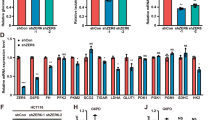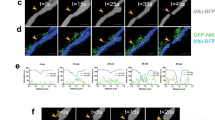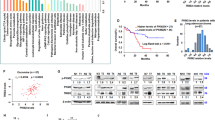Abstract
Cancer cells use aerobic glycolysis preferentially for energy provision1,2 and this metabolic change is important for tumour growth3,4. Here, we have found a link between the tumour suppressor p53, the transcription factor NF-κB and glycolysis. In p53-deficient primary cultured cells, kinase activities of IKKα and IKKβ and subsequent NF-κB activity were enhanced. Activation of NF-κB, by loss of p53, caused an increase in the rate of aerobic glycolysis and upregulation of Glut3. Oncogenic Ras-induced cell transformation and acceleration of aerobic glycolysis in p53-deficient cells were suppressed in the absence of p65/NF-κB expression, and were restored by GLUT3 expression. It was also shown that a glycolytic inhibitor diminished the enhanced IKK activity in p53-deficient cells. Moreover, in Ras-expressing p53-deficient cells, IKK activity was suppressed by p65 deficiency and restored by GLUT3 expression. Taken together, these data indicate that p53 restricts activation of the IKK–NF-κB pathway through suppression of glycolysis. These results suggest that a positive-feedback loop exists, whereby glycolysis drives IKK–NF-κB activation, and that hyperactivation of this loop by loss of p53 is important in oncogene-induced cell transformation.
This is a preview of subscription content, access via your institution
Access options
Subscribe to this journal
Receive 12 print issues and online access
$209.00 per year
only $17.42 per issue
Buy this article
- Purchase on Springer Link
- Instant access to full article PDF
Prices may be subject to local taxes which are calculated during checkout





Similar content being viewed by others
References
Warburg, O. On respiratory impairment in cancer cells. Science 124, 269–270 (1956).
Kim, J. W. & Dang, C. V. Cancer's molecular sweet tooth and the Warburg effect. Cancer Res. 66, 8927–8930 (2006).
Dang, C. V. & Semenza, G. L. Oncogenic alterations of metabolism. Trends Biochem. Sci. 24, 68–72 (1999).
Gatenby, R. A. & Gillies, R. J. Why do cancers have high aerobic glycolysis? Nature Rev. Cancer 4, 891–899 (2004).
Meller, J., Sahlmann, C. O. & Scheel, A. K. 18F-FDG PET and PET/CT in fever of unknown origin. J. Nucl. Med. 48, 35–45 (2007).
Hamroun, D. et al. The UMD TP53 database and website: update and revisions. Hum. Mutat. 27, 14–20 (2006).
Vogelstein, B., Lane, D. & Levine, A. J. Surfing the p53 network. Nature 408, 307–310 (2000).
Lowe, S. W., Jacks, T., Housman, D. E. & Ruley, H. E. Abrogation of oncogene-associated apoptosis allows transformation of p53-deficient cells. Proc. Natl Acad. Sci. USA 91, 2026–2030 (1994).
Tanaka, N. et al. Cellular commitment to oncogene-induced transformation or apoptosis is dependent on the transcription factor IRF-1. Cell 77, 829–839 (1994).
Bartek, J., Lukas, J. & Bartkova, J. DNA damage response as an anti-cancer barrier: damage threshold and the concept of 'conditional haploinsufficiency'. Cell Cycle 6, 2344–2347 (2007).
Serrano, M., Lin, A. W., McCurrach, M. E., Beach, D. & Lowe, S. W. Oncogenic ras provokes premature cell senescence associated with accumulation of p53 and p16INK4a. Cell 88, 593–602 (1997).
Finco, T. S. et al. Oncogenic Ha-Ras-induced signaling activates NF-κB transcriptional activity, which is required for cellular transformation. J. Biol. Chem. 272, 24113–24116 (1997).
Rayet, B. & Gelinas, C. Aberrant rel/nfκb genes and activity in human cancer. Oncogene 18, 6938–6947 (1999).
Ryan, K. M., Ernst, M. K., Rice, N. R. & Vousden, K. H. Role of NF-κB in p53-mediated programmed cell death. Nature 404, 892–897 (2000).
Webster, G. A. & Perkins, N. D. Transcriptional cross talk between NF-κB and p53. Mol. Cell. Biol. 19, 3485–3495 (1999).
Huang, W. C., Ju, T. K., Hung, M. C. & Chen, C. C. Phosphorylation of CBP by IKKα promotes cell growth by switching the binding preference of CBP from p53 to NF-κB. Mol. Cell 26, 75–87 (2007).
Janssens, S. & Tschopp, J. Signals from within: the DNA-damage-induced NF-κB response. Cell Death Differ. 13, 773–784 (2006).
Kondoh, H. et al. Glycolytic enzymes can modulate cellular life span. Cancer Res. 65, 177–185 (2005).
Schwartzenberg-Bar-Yoseph, F., Armoni, M. & Karnieli, E. The tumor suppressor p53 down-regulates glucose transporters GLUT1 and GLUT4 gene expression. Cancer Res. 64, 2627–2633 (2004).
Matoba, S. et al. p53 regulates mitochondrial respiration. Science 312, 1650–1653 (2006).
Mayo, M. W. & Baldwin, A. S. The transcription factor NF-κB: control of oncogenesis and cancer therapy resistance. Biochim. Biophys. Acta 1470, M55–62 (2000).
Zhong, H., Voll, R. E. & Ghosh, S. Phosphorylation of NF-κB p65 by PKA stimulates transcriptional activity by promoting a novel bivalent interaction with the co-activator CBP/p300. Mol. Cell 1, 661–671 (1998).
Macheda, M. L., Rogers, S. & Best, J. D. Molecular and cellular regulation of glucose transporter (GLUT) proteins in cancer. J. Cell Physiol. 202, 654–662 (2005).
Medina, R. A. & Owen, G. I. Glucose transporters: expression, regulation and cancer. Biol. Res. 35, 9–26 (2002).
Pahl, H. L. Activators and target genes of Rel/NF-κB transcription factors. Oncogene 18, 6853–6866 (1999).
Anest, V. et al. A nucleosomal function for IκB kinase-α in NF-κB-dependent gene expression. Nature 423, 659–663 (2003).
Yamamoto, Y., Verma, U. N., Prajapati, S., Kwak, Y. T. & Gaynor, R. B. Histone H3 phosphorylation by IKK-α is critical for cytokine-induced gene expression. Nature 423, 655–659 (2003).
Weisz, L. et al. Mutant p53 enhances nuclear factor κB activation by tumor necrosis factor α in cancer cells. Cancer Res. 67, 2396–2401 (2007).
Bensaad, K. et al. TIGAR, a p53-inducible regulator of glycolysis and apoptosis. Cell 126, 107–120 (2006).
Sato, M. et al. Distinct and essential roles of transcription factors IRF-3 and IRF-7 in response to viruses for IFN-α/β gene induction. Immunity 13, 539–548 (2000).
Acknowledgements
We thank T. Taniguchi, M. Oren, H. Hirata, K. Sada, S. Minami, S. Ohta, S. Asoh, O. Kawanami, I. Ohsawa, W. A. Martin, E. Oda-Sato, Y. Abe, W. Nakajima and M. Ando for discussion; T. Doi, S. Mise and Y. Asano for technical support; I. Uehara for preparation of MEFs; R. Agami for the retroviral vectors pSuper-sh human p53 puro; D. V. Goeddel for IKKα and IKKβ cDNA. This work was supported by Grants-in-aid from the Ministry of Education, Culture, Sports, Science and Technology of Japan.
Author information
Authors and Affiliations
Contributions
K. K. and N. T. designed the study; K. K., with contributions from K. A. and K. T., performed all experiments; K. K. and N. T. wrote the manuscript.
Corresponding author
Supplementary information
Supplementary Information
Supplementary Figures S1, S2, S3, S4, S5, S6, S7 (PDF 746 kb)
Rights and permissions
About this article
Cite this article
Kawauchi, K., Araki, K., Tobiume, K. et al. p53 regulates glucose metabolism through an IKK-NF-κB pathway and inhibits cell transformation. Nat Cell Biol 10, 611–618 (2008). https://doi.org/10.1038/ncb1724
Received:
Accepted:
Published:
Issue Date:
DOI: https://doi.org/10.1038/ncb1724
This article is cited by
-
Transcriptional regulation and post-translational modifications in the glycolytic pathway for targeted cancer therapy
Acta Pharmacologica Sinica (2024)
-
Hexokinase 2-mediated glycolysis supports inflammatory responses to Porphyromonas gingivalis in gingival fibroblasts
BMC Oral Health (2023)
-
To metabolomics and beyond: a technological portfolio to investigate cancer metabolism
Signal Transduction and Targeted Therapy (2023)
-
Loss of p53 function promotes DNA damage-induced formation of nuclear actin filaments
Cell Death & Disease (2023)
-
Flavinated SDHA underlies the change in intrinsic optical properties of oral cancers
Communications Biology (2023)



